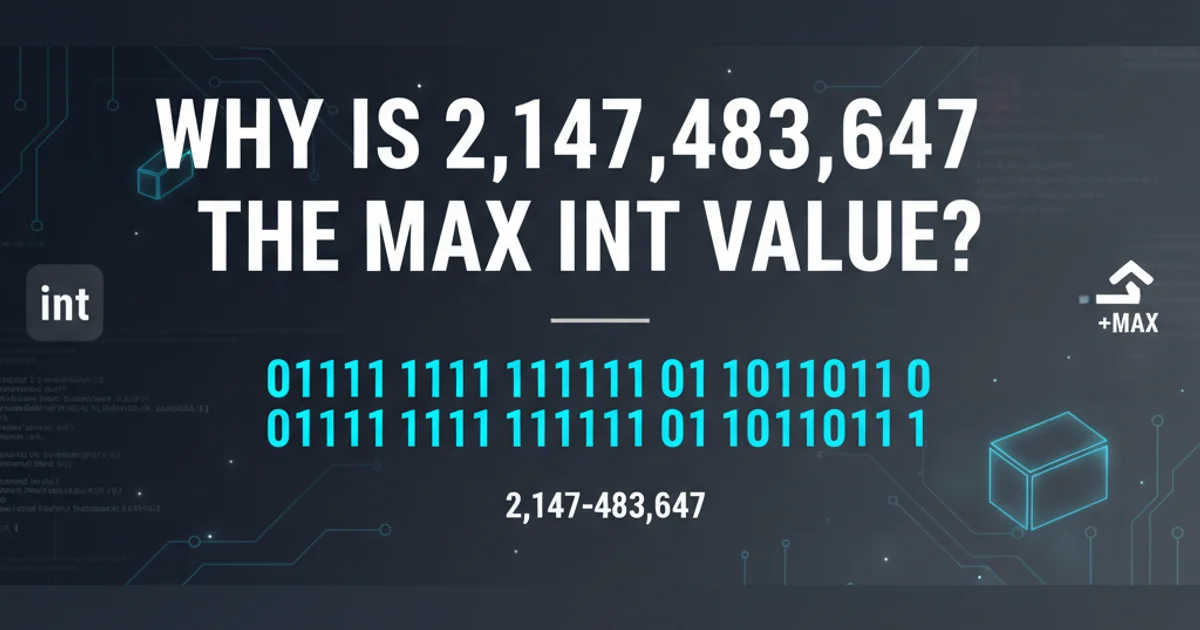Why is 2,147,483,647 the max int value?
Categories:
Understanding the 2,147,483,647 Integer Limit

Explore why 2,147,483,647 is the maximum value for a 32-bit signed integer, a fundamental concept in computer science and programming.
If you've ever encountered an unexpected overflow error or wondered why certain numbers seem to be 'magic limits' in programming, you've likely stumbled upon the maximum value for a 32-bit signed integer: 2,147,483,647. This number isn't arbitrary; it's a direct consequence of how computers store and represent numerical data using binary digits (bits). Understanding this limit is crucial for writing robust and efficient code, especially when dealing with large numbers or system-level programming.
The Foundation: Binary Representation
Computers operate using binary, a base-2 number system where all data is represented as sequences of 0s and 1s. Each 0 or 1 is called a bit. To store integers, a fixed number of bits are allocated. The most common allocation for integers in many programming languages and systems is 32 bits. This means an integer variable can hold a sequence of 32 binary digits.
flowchart LR
A[Decimal Number] --> B{Convert to Binary}
B --> C[Fixed-size Bit Storage (e.g., 32 bits)]
C --> D{Interpretation: Signed vs. Unsigned}
D --> E[Resulting Range of Values]Conceptual flow of integer representation in computers
Signed vs. Unsigned Integers
The key to understanding the limit lies in the distinction between signed and unsigned integers.
Unsigned Integers: These integers use all their bits to represent positive values, including zero. A 32-bit unsigned integer can represent values from 0 to 2^32 - 1 (which is 4,294,967,295).
Signed Integers: These integers need to represent both positive and negative values. To do this, one bit is designated as the 'sign bit'. By convention, the most significant bit (the leftmost bit) is used for the sign: 0 typically indicates a positive number, and 1 indicates a negative number. This leaves the remaining bits to represent the magnitude of the number.
int data type. If you need to store only positive numbers and require a larger range, consider using unsigned int in languages that support it (like C/C++) or long in Java.Two's Complement Representation
For signed integers, computers almost universally use a system called two's complement to represent negative numbers. This system simplifies arithmetic operations for the CPU. In two's complement:
- The most significant bit (MSB) indicates the sign (0 for positive, 1 for negative).
- Positive numbers are represented as their direct binary equivalent.
- Negative numbers are represented by inverting all bits of their positive counterpart and then adding 1.
With 32 bits, and one bit reserved for the sign, there are 31 bits left to represent the magnitude. The maximum positive value occurs when all 31 magnitude bits are 1 and the sign bit is 0. This translates to:
0111 1111 1111 1111 1111 1111 1111 1111 (binary)
Which is equal to 2^31 - 1.
Let's break down the calculation:
- Total bits: 32
- Sign bit: 1 (for positive/negative)
- Magnitude bits: 31
- Maximum positive value: 2^(number of magnitude bits) - 1
- Maximum positive value: 2^31 - 1 = 2,147,483,648 - 1 = 2,147,483,647.
public class MaxIntValue {
public static void main(String[] args) {
// The maximum value for a 32-bit signed integer in Java
int maxInt = Integer.MAX_VALUE;
System.out.println("Maximum int value: " + maxInt);
// What happens if you try to exceed it?
int overflowInt = maxInt + 1;
System.out.println("Max int + 1 (overflow): " + overflowInt);
// Binary representation of maxInt (first 32 bits)
System.out.println("Binary of maxInt: " + Integer.toBinaryString(maxInt));
// Binary of overflowInt
System.out.println("Binary of overflowInt: " + Integer.toBinaryString(overflowInt));
}
}
Java code demonstrating Integer.MAX_VALUE and integer overflow.
When you run the Java code above, you'll see that Integer.MAX_VALUE is indeed 2,147,483,647. More interestingly, maxInt + 1 results in -2,147,483,648. This is a classic example of integer overflow, where the value exceeds the maximum capacity of the data type, causing it to 'wrap around' to the minimum negative value due to the two's complement representation.
The Range of 32-bit Signed Integers
Using two's complement, the range for a 32-bit signed integer is from -2^31 to 2^31 - 1.
- Minimum Value: -2^31 = -2,147,483,648
- Binary:
1000 0000 0000 0000 0000 0000 0000 0000
- Binary:
- Maximum Value: 2^31 - 1 = 2,147,483,647
- Binary:
0111 1111 1111 1111 1111 1111 1111 1111
- Binary:
This asymmetrical range (one more negative number than positive) is a characteristic of two's complement, where the representation for zero is unique (all zeros), and the most negative number has no positive counterpart.
int limit, consider using long (64-bit signed integer) in Java, which has a much larger range (up to 9,223,372,036,854,775,807), or BigInteger for arbitrary-precision arithmetic.